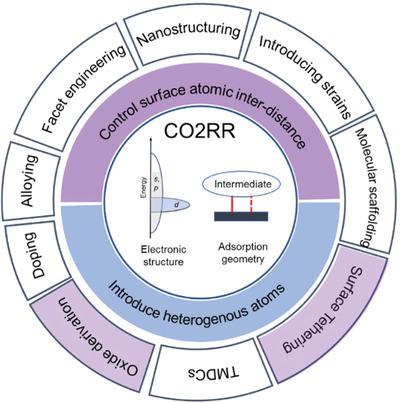当前位置:
X-MOL 学术
›
Small Methods
›
论文详情
Our official English website, www.x-mol.net, welcomes your
feedback! (Note: you will need to create a separate account there.)
Toward Excellence of Transition Metal‐Based Catalysts for CO2 Electrochemical Reduction: An Overview of Strategies and Rationales
Small Methods ( IF 10.7 ) Pub Date : 2020-04-16 , DOI: 10.1002/smtd.202000033 Mengran Li 1 , Sahil Garg 1 , Xiaoxia Chang 2 , Lei Ge 1, 3 , Liye Li 4 , Muxina Konarova 5 , Thomas E. Rufford 1 , Victor Rudolph 1 , Geoff Wang 1
Small Methods ( IF 10.7 ) Pub Date : 2020-04-16 , DOI: 10.1002/smtd.202000033 Mengran Li 1 , Sahil Garg 1 , Xiaoxia Chang 2 , Lei Ge 1, 3 , Liye Li 4 , Muxina Konarova 5 , Thomas E. Rufford 1 , Victor Rudolph 1 , Geoff Wang 1
Affiliation

|
Rational modulations of interactions between the catalyst surface and intermediates are challenging but extremely important to achieve an efficient and selective electrochemical CO2 reduction (CO2R). Current CO2R catalyst design remains inefficient because of a gap between existing practical design paradigms and theoretical studies in catalysis. This review attempts to mitigate this gap through a critical discussion of the correlations between recent strategies to develop transition metal‐based catalysts and the underlying rationales and mechanisms. These strategies include surface engineering, the introduction of heterogeneous atoms, and dimension control, and can be implemented by tactics such as controlling catalyst surface facets, surface tethering, alloying, inducing strains, oxide derivation, molecular scaffolding, and nanostructuring. How these tactics are able to tailor the electronic structure, adsorption geometry, density of active sites, and local environment of catalyst to achieve an efficient and selective CO2R is described. This review concludes with a discussion of the key research needs in this field such as the surface proton formation and transfer involved in CO2R, the roles of mass‐transfer or electrode kinetics in CO2R catalysis, development of robust, standardized catalyst testing protocols, and application of machine learning and high‐throughput experiment to accelerate catalyst screening processes.
中文翻译:

追求卓越的过渡金属基催化剂,用于二氧化碳的电化学还原:策略和原理概述
催化剂表面和中间体之间相互作用的合理调节是具有挑战性的,但对于实现有效和选择性的电化学CO 2还原(CO 2 R)极为重要。当前CO 2由于现有的实际设计范例和催化理论研究之间的差距,R催化剂的设计仍然没有效率。这篇综述试图通过对最近开发过渡金属基催化剂的策略与基本原理和机理之间的相关性进行批判性讨论,来缓解这种差距。这些策略包括表面工程,引入异质原子和尺寸控制,并且可以通过诸如控制催化剂表面刻面,表面系留,合金化,诱导应变,氧化物衍生,分子支架和纳米结构之类的策略来实施。这些策略如何能够调整电子结构,吸附几何形状,活性位点的密度以及催化剂的局部环境,以实现高效且选择性的CO 2描述了R。这篇综述最后讨论了该领域的关键研究需求,例如与CO 2 R有关的表面质子形成和转移,质量转移或电极动力学在CO 2 R催化中的作用,开发可靠的标准化催化剂测试协议,以及机器学习和高通量实验在加速催化剂筛选过程中的应用。
更新日期:2020-04-16
中文翻译:

追求卓越的过渡金属基催化剂,用于二氧化碳的电化学还原:策略和原理概述
催化剂表面和中间体之间相互作用的合理调节是具有挑战性的,但对于实现有效和选择性的电化学CO 2还原(CO 2 R)极为重要。当前CO 2由于现有的实际设计范例和催化理论研究之间的差距,R催化剂的设计仍然没有效率。这篇综述试图通过对最近开发过渡金属基催化剂的策略与基本原理和机理之间的相关性进行批判性讨论,来缓解这种差距。这些策略包括表面工程,引入异质原子和尺寸控制,并且可以通过诸如控制催化剂表面刻面,表面系留,合金化,诱导应变,氧化物衍生,分子支架和纳米结构之类的策略来实施。这些策略如何能够调整电子结构,吸附几何形状,活性位点的密度以及催化剂的局部环境,以实现高效且选择性的CO 2描述了R。这篇综述最后讨论了该领域的关键研究需求,例如与CO 2 R有关的表面质子形成和转移,质量转移或电极动力学在CO 2 R催化中的作用,开发可靠的标准化催化剂测试协议,以及机器学习和高通量实验在加速催化剂筛选过程中的应用。











































 京公网安备 11010802027423号
京公网安备 11010802027423号